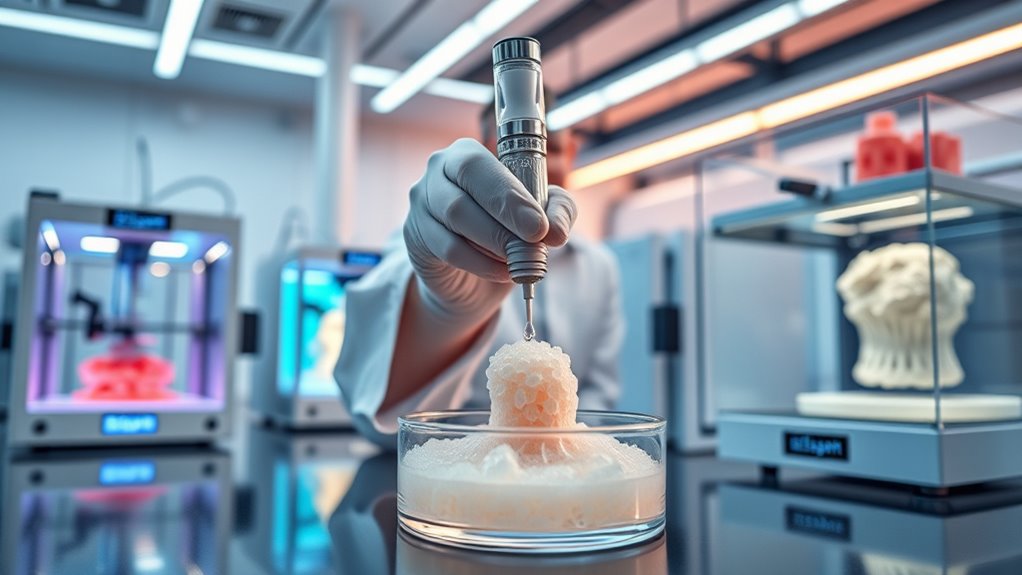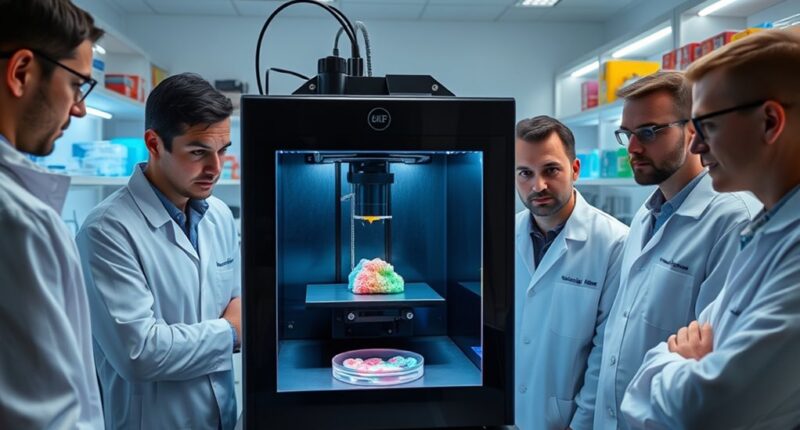CELLINK is a trailblazer in bioprinting, aiming to revolutionize medicine by creating living tissues and organs for regenerative therapies. They navigate evolving regulations, address ethical questions about creating life in labs, and work with regulatory agencies to guarantee safety and efficacy. Their commitment to responsible innovation drives progress in personalized healthcare and organ transplants. To discover more about how CELLINK shapes this promising future, keep exploring their inspiring journey.
Key Takeaways
- CELLINK is a leading innovator in bioprinting technology, aiming to revolutionize tissue engineering and regenerative medicine.
- The company develops advanced bioprinters and bioinks to enable the creation of functional, living tissues and organs.
- Navigating evolving regulatory frameworks and ethical considerations is central to CELLINK’s mission for clinical applications.
- CELLINK actively collaborates with regulators, scientists, and society to promote responsible innovation and transparency.
- Their future focus includes overcoming regulatory hurdles and advancing personalized, bioprinted healthcare solutions.

Have you ever wondered who is transforming medicine with the incredible technology of bioprinting? At the forefront of this revolution is CELLINK, a pioneering company that’s pushing the boundaries of what’s possible in tissue engineering and regenerative medicine. Their innovative approach combines cutting-edge bioprinting technology with a deep commitment to advancing healthcare. But as with any groundbreaking innovation, CELLINK faces significant hurdles, especially around regulatory challenges and ethical considerations. The path to bringing bioprinted tissues and organs to mainstream use isn’t straightforward. Regulatory agencies worldwide are still developing frameworks to evaluate the safety, efficacy, and quality of bioprinted products. This process can be lengthy and complex, requiring companies like CELLINK to navigate a patchwork of rules that vary across regions. They must guarantee their technology meets strict standards to gain approval for clinical applications, which demands rigorous testing, documentation, and adherence to evolving guidelines. These regulatory hurdles can slow down the pace of innovation but are essential for protecting patient safety. Alongside these challenges come ethical considerations that demand careful thought. The idea of bioprinting tissues and organs raises questions about the morality of creating living structures in the lab. For instance, concerns about manipulating human tissues or creating complex organs that could potentially be used for non-therapeutic purposes are hot topics in bioethics circles. CELLINK and other pioneers must consider the implications of their technology, ensuring their work aligns with societal values and moral standards. They need to foster transparency with the public and policymakers, emphasizing responsible innovation. Furthermore, issues related to donor tissue sourcing, consent, and accessibility are critical to address. As bioprinting moves closer to clinical reality, these ethical considerations become more pressing, demanding ongoing dialogue between scientists, regulators, and society. CELLINK’s journey exemplifies how innovation often travels hand-in-hand with these challenges. The company actively collaborates with regulatory bodies to shape policies that accommodate this emerging field while prioritizing safety and ethics. Their commitment to responsible innovation helps pave the way for future breakthroughs that could revolutionize organ transplants, drug testing, and personalized medicine. Additionally, understanding the regulatory landscape and ongoing ethical debates is crucial for supporting sustainable development in bioprinting. Yet, the road ahead requires patience, persistent effort, and a careful balance between technological progress and societal values. As you follow CELLINK’s story, it becomes clear that overcoming regulatory and ethical hurdles is just as important as perfecting the technology itself, guaranteeing that bioprinting benefits humanity in a safe, responsible manner.
Frequently Asked Questions
What Inspired Cellink’s Founders to Pursue Bioprinting Technology?
You’re inspired by the potential of technological innovations to revolutionize healthcare, especially in addressing ethical considerations around organ transplants and regenerative medicine. The founders saw bioprinting as a way to create personalized tissues, reducing donor shortages and improving outcomes. Their passion drives them to push boundaries, combining scientific progress with ethical responsibility, to develop solutions that could one day save countless lives.
How Does Cellink’s Technology Differ From Competitors?
You’ll find that Cellink’s technology stands out through its focus on bioprinting scalability and tissue engineering innovation. Their solutions enable you to produce complex, patient-specific tissues efficiently, pushing the boundaries of regenerative medicine. Unlike competitors, Cellink offers user-friendly, versatile bioprinters and bioinks that foster faster development and higher precision. This commitment helps you accelerate research, personalized treatments, and ultimately, breakthroughs in healthcare.
What Are Cellink’s Future Plans for Clinical Applications?
You’ll see CELLINK focusing on overcoming regulatory hurdles to bring their bioprinting solutions into clinical applications. They plan to expand into new markets by collaborating with healthcare providers and regulatory bodies. This strategic move aims to accelerate the translation of bioprinted tissues and organs from research to real-world medical treatments, ultimately improving patient outcomes and establishing CELLINK as a leader in the emerging field of regenerative medicine.
How Does CELLINK Ensure the Safety of Bioprinted Tissues?
Picture a spaceship maneuvering through space, carefully avoiding hazards—that’s how Cellink guarantees safety. You’re protected by strict safety protocols and rigorous quality assurance processes, which verify each bioprinted tissue’s biocompatibility and structural integrity. They conduct thorough testing and adhere to industry standards, reducing risks of rejection or failure. By maintaining high safety standards, Cellink keeps your bioprinted tissues safe, reliable, and ready for clinical use.
What Challenges Did CELLINK Face During Commercialization?
During commercialization, you face significant challenges like regulatory hurdles and funding challenges. Steering complex regulations requires careful compliance, which can delay product launches and increase costs. Securing consistent funding proves tough, especially when innovation is high-risk. You must persist through these obstacles by building strategic partnerships, demonstrating safety and efficacy, and adapting your approach to meet evolving standards, ensuring your bioprinting solutions reach the market successfully.
Conclusion
Just as explorers chart uncharted waters, Cellink navigates the vast ocean of bioprinting innovation. Their pioneering spirit acts as a guiding star, illuminating new paths toward healing and regeneration. With each breakthrough, they steer closer to a future where lab-grown organs become reality. Stay inspired by their voyage—because in this grand adventure, you’re part of the crew shaping tomorrow’s medical miracles. The journey has just begun, and the horizon is waiting.








